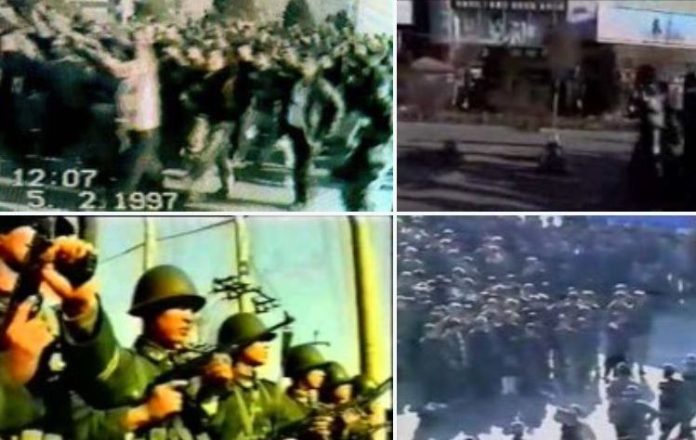In the annals of history, February 5, 1997, etched a painful chapter in the story of the Uyghur people. On that fateful day, the streets of Ghulja resonated with the heartfelt pleas of Uyghur men, women, and children seeking equality, religious and cultural freedom, and the right to express themselves without repression. Their peaceful demonstration, however, was met with brutal force from units of the Chinese People’s Armed Police and riot police leading to Ghulja massacre.
Backdrop of the Massacre
Ghulja massacre was the culmination of the protest, a series of demonstrations in the city of Yining—known as Ghulja in Uyghur—in the Xinjiang autonomous region of China. During 1980s, the mishrep, a traditional Uyghur male gathering, which involves music, dance, and poetry, was popular. In the mid-1990s, China, which is clearly an authoritarian regime that controls every aspect of common life, began to consider the mishrep as threat as it was alien to mainland China. Accordingly, China launched, what is known as, “Strike Hard” campaign. Under this campaign in 1996, China jailed Abduhelil Abdurahman, a prominent organiser of meshrep meetings, and subsequently beat him to death by Chinese authorities in Xinjiang, while in custody. Meshrep organisers and attendees became the primary targets of “Strike Hard” campaign.
Under this Strike Hard, a group of women were also arrested for participating in Meshrep on 3rd February 1997. While the Uyghurs were struggling to preserve their culture and tradition, the arrests prompted them to stage a protest. On February 5, the protestors started demonstrations and marched saying “God is great” and “Independence for Xinjiang.” The Chinese police launched a crackdown over the peaceful protestors.
Ghulja massacre reality that unveiled afterwards
Tragic scene unfolded as security forces opened fire into the crowd, resulting in the immediate death of as many as 30 Uyghurs, with over a hundred sustaining injuries. This tragedy marked a turning point, highlighting the daily racial discrimination faced by the Uyghur community, leading to their cultural and economic marginalization.
While the Chinese authorities tried to blame the protestors and downplay the massacre, the aftermath revealed a stark miscarriage of justice. An Amnesty International report in April 1999 uncovered that over 200 Uyghurs faced execution for their participation in the peaceful protest. Shockingly, this injustice continued as Uyghurs were imprisoned for their role in the Ghulja demonstration, while the perpetrators of the violent crackdown remained unaccountable.
The echoes of the Ghulja Massacre persisted, reflecting a cycle of repression and the desperate cry for justice and freedom.
Recurring incidents
Since then, there have been number of incidents where Uyghurs have been massacred. One such incident unfolded on July 5, 2009 in Urumchi.
Reportedly, Chinese action in Urumchi led to detainment of thousands of Uyghurs. Many were simply disappeared off the face of the earth; at least nine have been executed after unfair trials. Unfortunately, neither the Ghunja was last nor the Urumchi. In fact, Chinese persecution and systematic purge are becoming more subtle and appalling. This year marks the 27th anniversary of the Ghulja Massacre, it becomes a poignant reminder of the ongoing struggles faced by the Uyghur community in occupied region. Even more, the massacre reminds that the international community must not avert its gaze from the systematic human rights violations perpetrated against the Uyghur population.
The cry for justice and freedom that reverberated through the streets of Ghulja in 1997 remains undiminished. The Uyghur struggle is a testament to the enduring human spirit and the quest for dignity, freedom, and the right to exist without fear. This anniversary is a clarion call for global solidarity and action. As the world marks the 27th anniversary of the Ghulja Massacre, it is a moment to reaffirm our collective commitment to human rights and justice for the Uyghurs.

